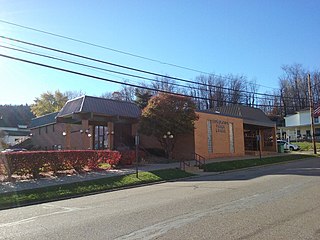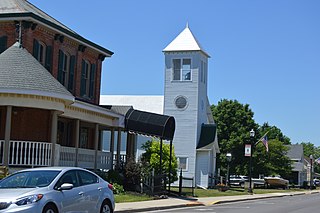
Shelby County is a county in the western portion of the U.S. state of Ohio. As of the 2020 United States Census, the population was 48,230. Its county seat is Sidney. Its name honors Isaac Shelby, first governor of Kentucky.

Old Mill Creek is a village in Lake County, Illinois, United States. Per the 2020 census, the population was 162.

Leonard is a village in northwestern Shelby County, Missouri, United States. The population was 57 at the 2020 census.

St. Marys is a city in Auglaize County, Ohio, United States. Located in western Ohio, it is 11 miles (18 km) west of Wapakoneta and 20 miles (32 km) east of the Ohio–Indiana border. Founded in 1823, the city is located on a portage between the St. Marys and Auglaize river systems, which was a significant factor in its development before the era of canals. The population was 8,397 at the 2020 census. It is included in the Wapakoneta micropolitan area.

Milledgeville is a village in Jasper Township, Fayette County, Ohio, United States. The population was 98 at the 2020 census.

Byesville is a village in Guernsey County, Ohio, United States, along Wills Creek. The population was 2,364 at the 2020 census.

Lockland is a village in Hamilton County, Ohio, United States. The population was 3,514 at the 2020 United States Census. Lockland is located in southwest Ohio, north of Cincinnati.

Bowerston is a village in Harrison County, Ohio, United States. The population was 356 at the 2020 census.

Irondale is a village in northern Jefferson County, Ohio, United States. The population was 326 at the 2020 census. It is part of the Weirton–Steubenville metropolitan area.

Mingo Junction is a village in eastern Jefferson County, Ohio, United States, along the Ohio River. The population was 3,347 at the 2020 census. It is part of the Weirton–Steubenville metropolitan area.

Middleport is the largest village in Meigs County, Ohio, along the Ohio River. The population was 2,208 at the time of the 2020 census.

Shelby is a city in Richland County in the U.S. state of Ohio, northwest of the city of Mansfield. It is part of the Mansfield, Ohio Metropolitan Statistical Area. The population was 9,282 as of the 2020 census.

Anna is a village in Shelby County, Ohio, United States. The population was 1,470 at the 2020 census.

Botkins is a village in Shelby County, Ohio, United States. The population was 1,155 at the 2020 census.

Fort Loramie is a village in Shelby County, Ohio, United States, along Loramie Creek, a tributary of the Great Miami River in southwestern Ohio. It is 42 mi. north-northwest of Dayton and 20 mi. east of the Ohio/Indiana border. The population was 1,590 at the 2020 census. The village was founded in 1837 near the former site of a colonial fort of the same name.

Jackson Center is a village in Shelby County, Ohio, United States. The population was 1,441 at the 2020 census.

Kettlersville is a village in Shelby County, Ohio, United States. The population was 164 at the 2020 census.

Port Jefferson is a village in Salem Township, Shelby County, Ohio, United States. The population was 308 at the 2020 census.

Russia is a village in Loramie Township, Shelby County, Ohio, United States. The population was 712 at the 2020 census.

Lowell is a village in Washington County, Ohio, United States, along the Muskingum River. The population was 549 at the 2020 census. The village is located about 7.6 miles (12.2 km) north of Marietta, Ohio.























